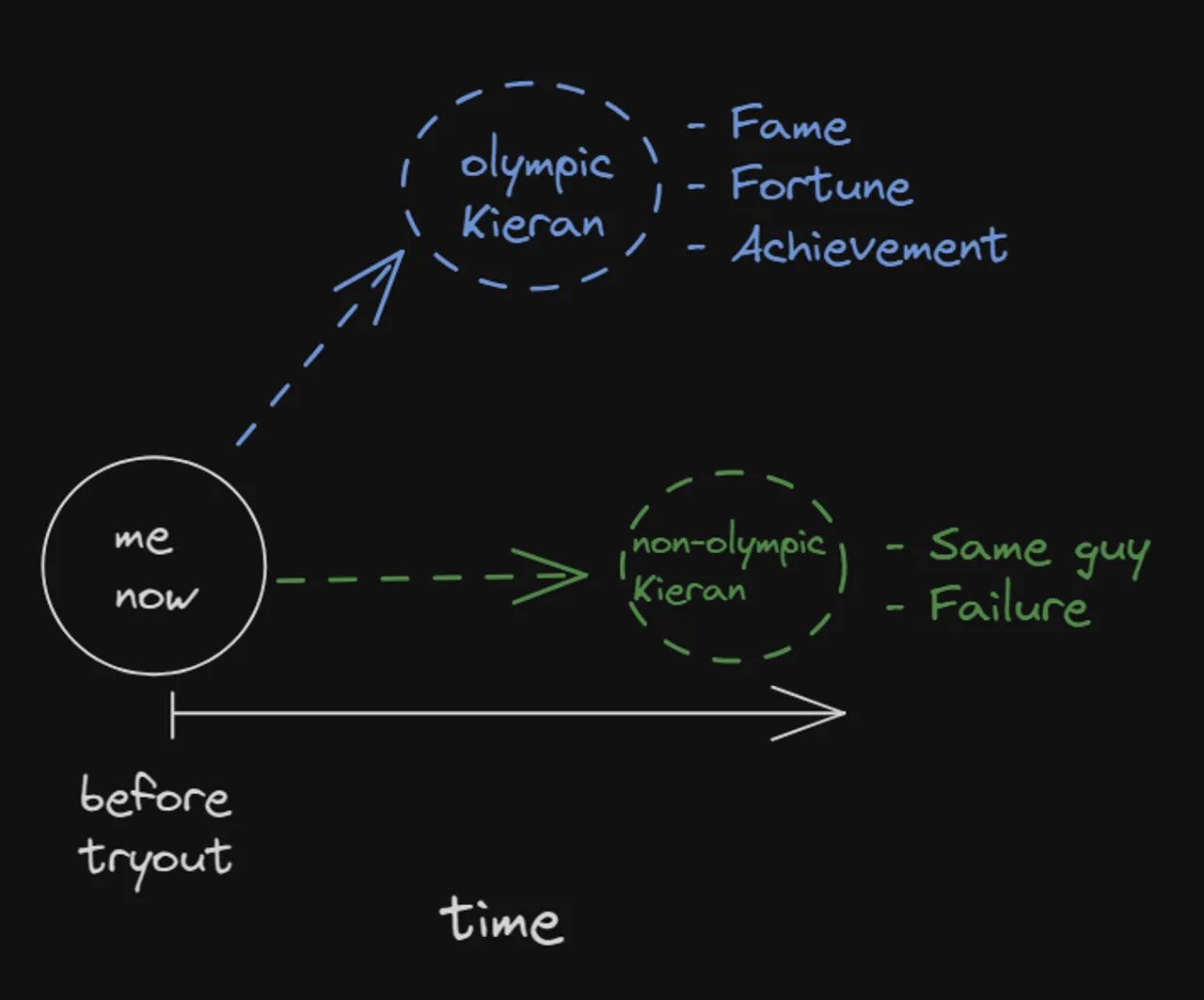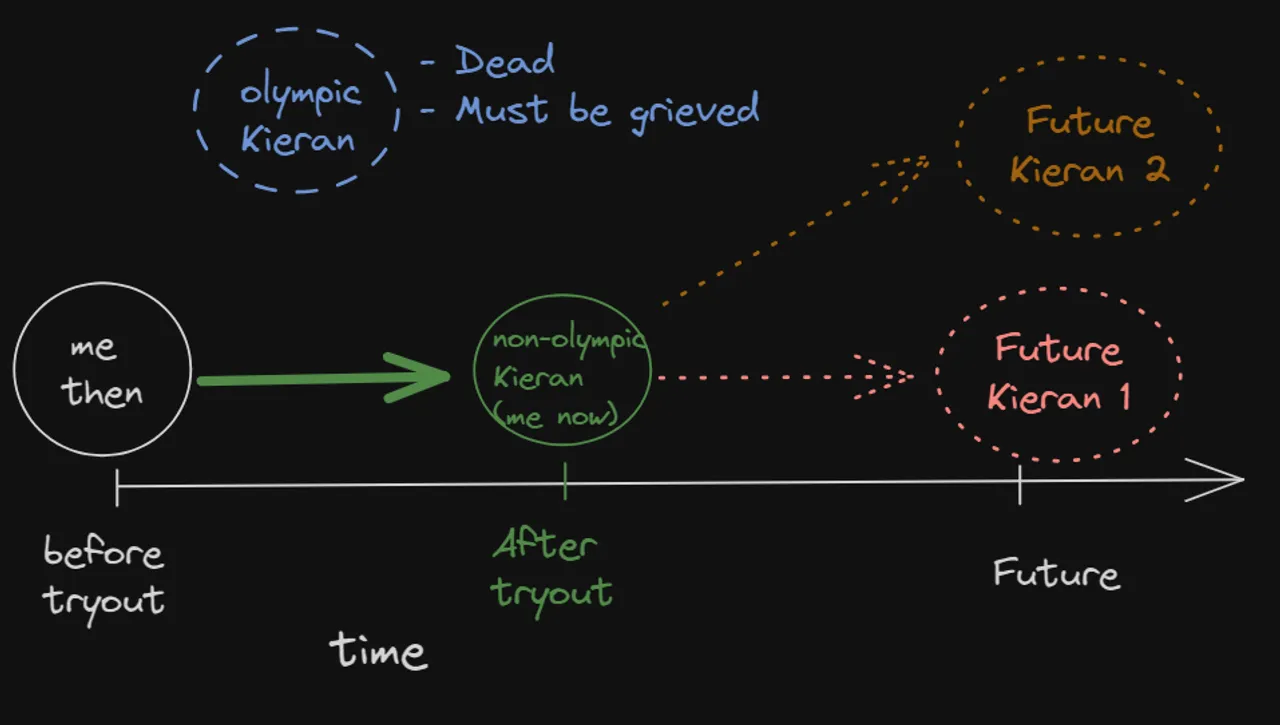“Do not fear failure but rather fear not trying.”
- Roy T. Bennett, The Light in the Heart 1
Many people struggle with self-confidence. As part of this there can be a welling up of anxiety in a situation where you need to do something2. Maybe it’s doing something new, or something you were/are good at, what matters is there’s an expectation to perform in some way. Sometimes these can be externally influenced, but often the internal forces are the loudest, so that’s what we’ll focus on. To make this concrete let’s take an example.
You have a recital for an instrument you’ve started learning. As the day is approaching you begin getting anxious about what happens if you mess up. What if you forget how to do a section? What if you hit the wrong keys? You’ve been working for months for this moment all to fuck it up when it matters most. How are you going to justify the time and money you spent to be this much of a fuck up? What will the people you invited think…
The anxiety continues, and at this point you’re so disappointed with your performance that you don’t even want to bother. But you aren’t disappointed with your experience. You’re disappointed with a possible performance that hasn’t even happened yet.
Possible vs real
A few years ago I read Kierkegaard’s Sickness Unto Death3, and in it there’s a section where he talks about despair over possibility. Kierkegaard posits than when you fail to live up to an expectation, you are not necessarily upset about what happened, but grieving over the loss of the person you could have been if that thing didn’t happen. For example if you fail an Olympic tryout, it’s not that you failed that’s the problem, after all there’s always next year, you are upset about losing the possible version of yourself that is an Olympic athlete:
Possibilities before tryout

Actuality afterwards, with future possibilities

I think this model of despair can also be useful for understanding yourself, and helping actualize your possibilities. I argue there is not 1 self, but a current self that is an iteration in a long series of “selves”. These selves are always transient, and who you are does not always have to be set in stone. With this mental model there is obviously a difficulty in understanding yourself with an ever-changing situation.
So, with that framework in place we can start looking at the phenomenon described earlier. For the recital you have a situation where you are treating a possible self as if it’s a real self. You have already failed in your mind, and you are at the “after tryout” portion of the diagram, but you haven’t actually been through the situation. It’s very easy to be thinking 10-12 steps ahead of what’s happening now, but it’s important to always keep in mind what’s really in front of you. There are several issues with being so infatuated with a possible future.
Look where you leap
There’s an old saying when learning to ride a bike that where you look is where you go. If you look where you might fall, you’ll end up there. I would argue a lot of the same is true with other situations. If you assume you’re going to fail the recital, then it’s likely to become a self-fulfilling prophecy. Whether it be the anxiety that makes you perform worse, or just the distraction from practicing, there’s many ways that this can manifest. This will likely end up with a worse situation than if you didn’t even consider your failure in the first place. If you agree with the “you go where you look” framing, then you have now also primed yourself to be disappointed with anything.
Let’s say the recital goes fine, not phenomenal, just pretty well and not poorly. You have already been living in such a miserable situation for the last little while that you will be primed to think negatively of it. Every slightly missed tempo is proof you were correct, every detail becomes support for your overall failure. You looked, now you’re leaping exactly where your eyes went. So, pay no heed to the future, and whatever happens, happens, right?
Well, let’s be a bit more measured. Making a plan for the future is fine, but that plan should be actionable. Wherever the possible meets the real is where your time should be placed. For example let’s say because of your anxiety you plan 2 hours a week of extra practice each week, or try to find ways to de-stress before your performance. These are things that you can actually do, as opposed to lamenting things that don’t exist.
Conclusion
If you assume you will fail, then often you will. Anxiety can be a great force for change and improvement, but it can also be a hinderance or detriment to improvement and stability. If you premeditate your own misery, you’ll find it. Alternatively if you use that anxiety as a impetuous to act differently it can be incredibly useful. The choice is yours, but remember that whichever you choose is much more likely to come to fruition.
Footnotes
-
Bennett, Roy. n.d. The Light in the Heart. ISBN: 978-0987917751 Accessed December 24, 2023. https://www.goodreads.com/book/show/29359991-the-light-in-the-heart. ↩
-
5 Truths about Anxiety to Help You Stay Present | Psychology Today ↩
-
The Sickness Unto Death : S. Kierkegaard : Free Download, Borrow, and Streaming : Internet Archive ↩
